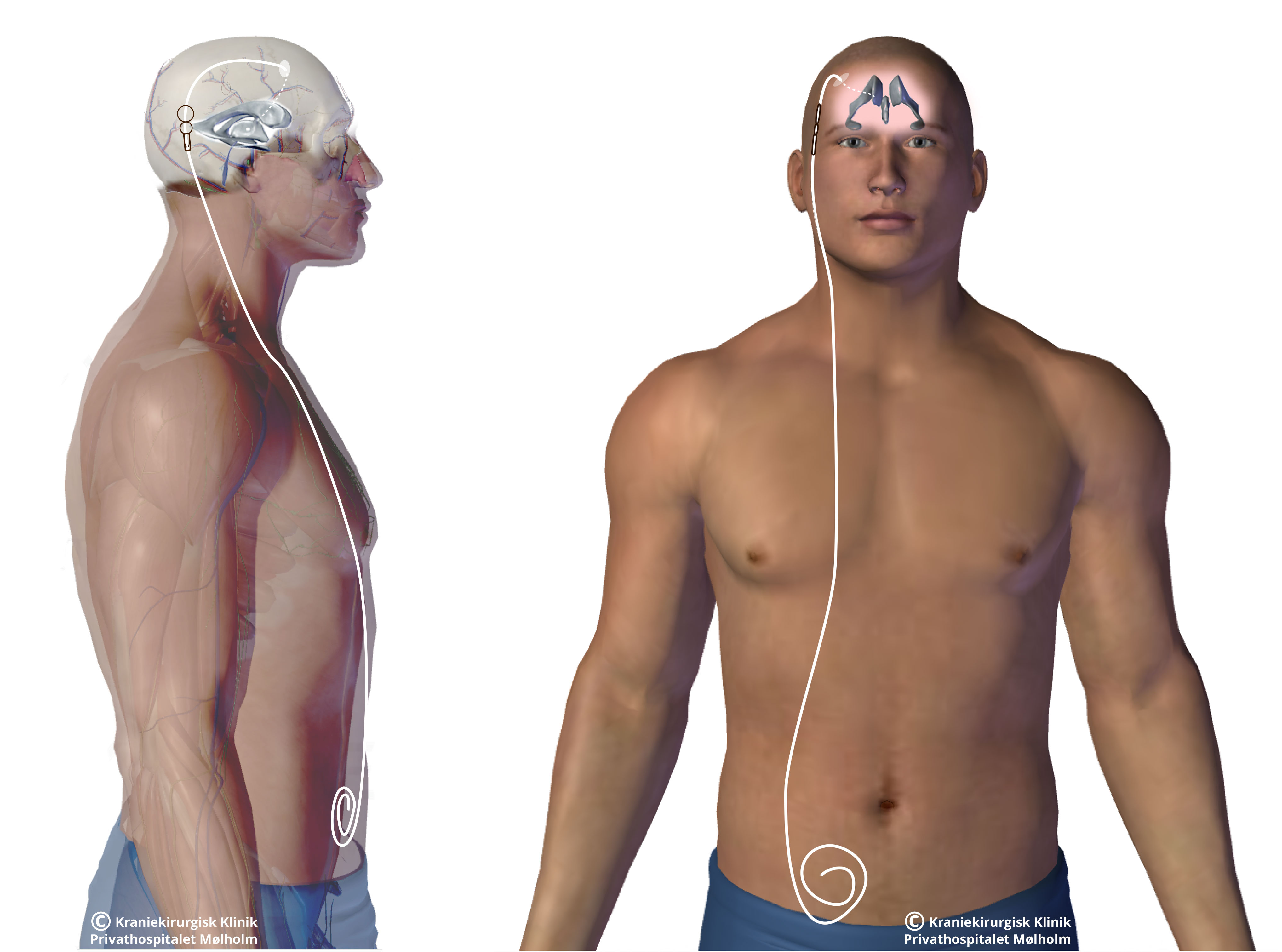Diagnosing, examination and treatment of normal pressure hydrocephalus (NPH)
If you take blood thinners or any forms of natural medicine or food supplements, you need to pause those before the examination, see the given medicine list.
We urge you to take a relative with you to the examination.
We ask you to take your daily morning medicine (apart from the blood thinners) at home and bring the medicine you normally take during the day.
The examination
The examination takes place in the ambulatory of the private hospital in Mølholm.
Before the examination, we need an MRI of your brain. If you cannot get an MRI done, you get a CT-scan. Most patients have gotten a scan before they are referred for diagnosing NPH.
Initially our neurologist and neurosurgeon are examining you, ensuring that your symptoms fit NPH and ruling out that there could be other explanations to your symptoms.
If we conclude that your condition matches NPH, we can offer you treatment with an operation inserting a ventriculo-peritoneal shunt. Often the diagnosis is not straight away and there is a need for measuring the pressure in the brain supplemented by a so-called TAP-test. This examination is done the same day.
Examination with measuring the brain pressure
First, you have to go through a gait test, where you are asked to walk in the hallway, while your gait is filmed.
Afterwards, you are getting pressure measured. It is either our neurologist or neurosurgeon performing the measurement. You have to lay on the side in the bed with your top pushed up. You get a blanket over yourself. You have to bend your spine by pull your knees up to your chin and bend your head forwards to open the lumbar vertebrae. It is important that you lay very still under the examination.
First, you get some local anesthesia and afterwards a cannula is placed between two vertebrae into the spinal canal. You feel when the doctor gives you the local anesthesia. The anesthesia does not work close to the bone, so you can feel if the cannula touches a bone. If the cannula touches a nerve, you can feel passing pains that radiate down to the leg. It is important, that you tell us, what you feel. There are sometimes being taken samples of the spinal fluid before the needle is connected to the measuring device.
The doctor will inform you during the process.
Tap-test
At the tap-test, the doctor taps out 40-50ml of spinal fluid before the cannula is removed. After this, you have to lay down for 30 minutes to 1 hour. Then the gait test is repeated and filmed once again.
You will be contacted by the doctor a week after the examination. If you are walking better, the tap test is positive and you will be offered a shunt. If the test is negative, your treatment at Mølholm most likely ends.
If you are offered a ventriculo-peritoneal shunt (VP-shunt), we will find a suitable date for surgery together.
You have to expect the examination can take up to 2,5 hour, if you are being offered a shunt.
Operation with insertion of a ventriculo-peritoneal shunt (VP-shunt) at normal pressure hydrocephalus (NPH)
If our examinations show, that you most likely will have effect of a shunt, we can offer you the insertion of a VP-shunt.
What is a VP-shunt?
A VP-shunt is a drainage system, that is inserted surgically when there is too much fluid in the head. The drainage runs from the cavities in the brain and under the sub cutis to the peritoneal cavity. To ensure close to natural pressure in the brain, a little resistance-chamber is inserted into the tube.
Even though a VP-shunt is placed under the sub cutis, it can be palpated with the fingers.

How is the surgery done?
The surgery takes place in full anesthesia. Therefore, you have to be on an empty stomach 6 hours prior to the operation.
When you are sleeping, we remove a narrow part of your hair, normally on the right side of the head. We do 3 cuts. One behind your hairline, one behind your ear and one just above the belly button. We drill a little hole in your skull to be able to insert the shunt. The wounds are closed by suture. You will therefore have 3 wounds when you wake up after surgery. The operation itself takes about 45 minutes.
It is important, that you try to get up and walk on the same day.
Before releasing you, you will have a conversation with a nurse and the doctor that operated you.
After a month, we will contact you on the phone to hear how you are doing. We will also offer you participation in several research projects about NPH, which lead to more follow-ups.
Your participation is voluntary.
Problems after surgery
It is normal to have wound pain after surgery, but they should decline after the first days. You can experience headaches the first period after the operation. These should decline, too.
Blood-thinning treatment
If you are getting treatment with a blood-thinning agent, also called AC-treatment (anti-coagulation treatment), or other treatment that prevents the blood from clotting, you have to stop taking this medicine as described further below. If you do not stop taking the medicine in good time, your surgery can be at risk of being cancelled.
Contact us
If you take Marcoumar, Marevan, Waran or Warfarin, you have to talk to one of the doctors in the department in good time ahead of the operation, because you might be in need of some other medicine instead of. If you have to swap to a different kind of medicine, it has to happen 1 week before surgery, hence the importance to contact us in good time before your surgery.
If you take any of the medicine below you have to stop
1 WEEK BEFORE SURGERY
Apixaban, as in Eliquis
Clopidogrel, as in Clopidogrel, Cloriocard, Grepld, Plavix
Dabigatran, as in Pradaxa
Prasugrel, as in Efient
Rivaroxaban, as in Xarelto
Ticaqrelor, as in Brilique
Medicine with Acetylsalicylic Acid, as in
Asasantin, Aspirin
- Hjerdyl, Hjertealbyl, Hjertemagnyl, Hjertemin
- ldotyl
- Kodimagnyl
- Magnyl
- Treo
Nature medicine or food supplements, as in
- Echinamin
- Fish oil
- HUSK (Physillium husk)
- Garlic (tablets)
- Ginger (tablets and "shots")
- Longovital
- Melbrosia
- Omnix
Specialists and practitioners



